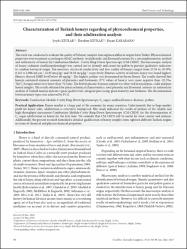Characterization of Turkish honeys regarding of physicochemical properties, and their adulteration analysis
Abstract
This work was conducted to evaluate the quality of 54 honey samples from eighteen different origins from Turkey. Physicochemical properties were examined according to AOAC methods, total phenolic and flavonoid contents by a spectrophotometric method and authenticity of honeys by Combustion Module-Cavity Ring-Down Spectroscopy (CM-CRDS). The microscopic analysis of honey sediment (mellissopalynology) was carried out to identify and count the pollen to provide qualitative indicators to confirm botanical origin. The moisture, electrical conductivity and free acidity of honeys ranged from 15.56 to 18.39%, 0.143 to 2.006 mS.cm(-1), 16.05 meq.kg(-1) and 34.10 meq.kg(-1), respectively. Diastase activity of sideritis honey was found highest. Honeys showed HMF level below 40 mg.kg-1. The highest proline was determined in thyme honey. The results showed that honeys contained eminent amounts of phenolics and flavonoids. delta C-13 values of honeys were more negative than -23.5%. The C-4% sugar ratios were lower than 7% value. The lowest glucose-fructose content was observed in eucalyptus, cedar and pine honey samples. The results obtained for physicochemical characteristics, total phenolic and flavonoid contents an authenticity analysis of Turkish honeys indicate a good quality level, adequate processing, good maturity and freshness. The discrimination between honey types was achieved by PCA.


















